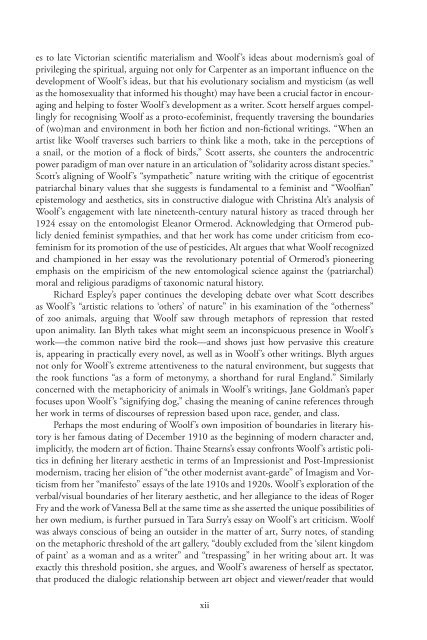Woolfian Boundaries - Clemson University
Woolfian Boundaries - Clemson University
Woolfian Boundaries - Clemson University
Create successful ePaper yourself
Turn your PDF publications into a flip-book with our unique Google optimized e-Paper software.
es to late Victorian scientifi c materialism and Woolf’s ideas about modernism’s goal of<br />
privileging the spiritual, arguing not only for Carpenter as an important infl uence on the<br />
development of Woolf’s ideas, but that his evolutionary socialism and mysticism (as well<br />
as the homosexuality that informed his thought) may have been a crucial factor in encouraging<br />
and helping to foster Woolf’s development as a writer. Scott herself argues compellingly<br />
for recognising Woolf as a proto-ecofeminist, frequently traversing the boundaries<br />
of (wo)man and environment in both her fi ction and non-fi ctional writings. “When an<br />
artist like Woolf traverses such barriers to think like a moth, take in the perceptions of<br />
a snail, or the motion of a fl ock of birds,” Scott asserts, she counters the androcentric<br />
power paradigm of man over nature in an articulation of “solidarity across distant species.”<br />
Scott’s aligning of Woolf’s “sympathetic” nature writing with the critique of egocentrist<br />
patriarchal binary values that she suggests is fundamental to a feminist and “Woolfi an”<br />
epistemology and aesthetics, sits in constructive dialogue with Christina Alt’s analysis of<br />
Woolf’s engagement with late nineteenth-century natural history as traced through her<br />
1924 essay on the entomologist Eleanor Ormerod. Acknowledging that Ormerod publicly<br />
denied feminist sympathies, and that her work has come under criticism from ecofeminism<br />
for its promotion of the use of pesticides, Alt argues that what Woolf recognized<br />
and championed in her essay was the revolutionary potential of Ormerod’s pioneering<br />
emphasis on the empiricism of the new entomological science against the (patriarchal)<br />
moral and religious paradigms of taxonomic natural history.<br />
Richard Espley’s paper continues the developing debate over what Scott describes<br />
as Woolf’s “artistic relations to ‘others’ of nature” in his examination of the “otherness”<br />
of zoo animals, arguing that Woolf saw through metaphors of repression that rested<br />
upon animality. Ian Blyth takes what might seem an inconspicuous presence in Woolf’s<br />
work—the common native bird the rook—and shows just how pervasive this creature<br />
is, appearing in practically every novel, as well as in Woolf’s other writings. Blyth argues<br />
not only for Woolf’s extreme attentiveness to the natural environment, but suggests that<br />
the rook functions “as a form of metonymy, a shorthand for rural England.” Similarly<br />
concerned with the metaphoricity of animals in Woolf’s writings, Jane Goldman’s paper<br />
focuses upon Woolf’s “signifying dog,” chasing the meaning of canine references through<br />
her work in terms of discourses of repression based upon race, gender, and class.<br />
Perhaps the most enduring of Woolf’s own imposition of boundaries in literary history<br />
is her famous dating of December 1910 as the beginning of modern character and,<br />
implicitly, the modern art of fi ction. Th aine Stearns’s essay confronts Woolf’s artistic politics<br />
in defi ning her literary aesthetic in terms of an Impressionist and Post-Impressionist<br />
modernism, tracing her elision of “the other modernist avant-garde” of Imagism and Vorticism<br />
from her “manifesto” essays of the late 1910s and 1920s. Woolf’s exploration of the<br />
verbal/visual boundaries of her literary aesthetic, and her allegiance to the ideas of Roger<br />
Fry and the work of Vanessa Bell at the same time as she asserted the unique possibilities of<br />
her own medium, is further pursued in Tara Surry’s essay on Woolf’s art criticism. Woolf<br />
was always conscious of being an outsider in the matter of art, Surry notes, of standing<br />
on the metaphoric threshold of the art gallery, “doubly excluded from the ‘silent kingdom<br />
of paint’ as a woman and as a writer” and “trespassing” in her writing about art. It was<br />
exactly this threshold position, she argues, and Woolf’s awareness of herself as spectator,<br />
that produced the dialogic relationship between art object and viewer/reader that would<br />
xii
















